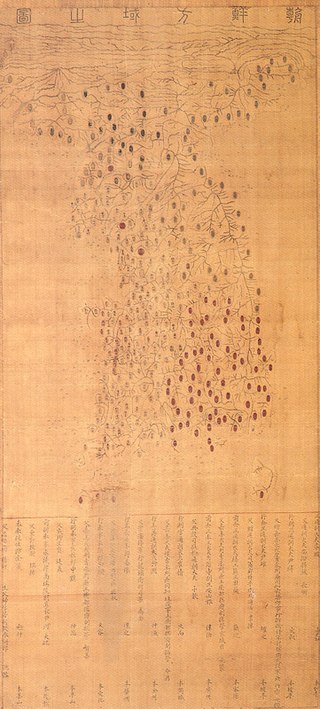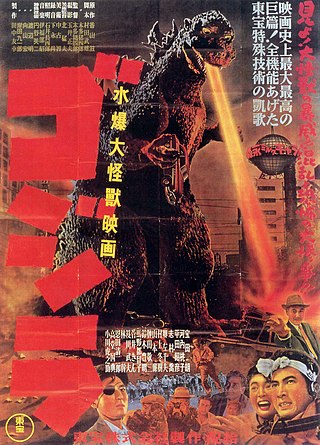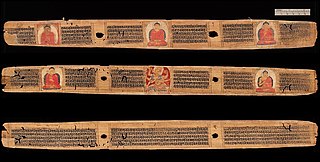Related Research Articles

Korea is a peninsular region in East Asia. Since 1945, it has been divided at or near the 38th parallel, now known as the Korean Demilitarized Zone. In 1948, two states declared independence, both claiming sovereignty over all of Korea: South Korea comprising its southern half and North Korea comprising its northern half. The region consists of the Korean Peninsula, Jeju Island, and a number of minor islands near the peninsula. The peninsula is bordered by China (Manchuria) to the north and Russia to the northeast, across the Amnok and Duman rivers. It is separated from Japan to the southeast by the Korea Strait.

The Lower Paleolithic era on the Korean Peninsula and in Manchuria began roughly half a million years ago. The earliest known Korean pottery dates to around 8000 BC, and the Neolithic period began after 6000 BC, followed by the Bronze Age by 2000 BC, and the Iron Age around 700 BC. Similarly, according to The History of Korea, the Paleolithic people are not the direct ancestors of the present Korean people, but their direct ancestors are estimated to be the Neolithic People of about 2000 BC.

Although definitions of music vary wildly throughout the world, every known culture partakes in it, and it is thus considered a cultural universal. The origins of music remain highly contentious; commentators often relate it to the origin of language, with much disagreement surrounding whether music arose before, after or simultaneously with language. Many theories have been proposed by scholars from a wide range of disciplines, though none has achieved broad approval. Most cultures have their own mythical origins concerning the invention of music, generally rooted in their respective mythological, religious or philosophical beliefs.

Shorts are a garment worn over the pelvic area, circling the waist and splitting to cover the upper part of the legs, sometimes extending down to the knees but not covering the entire length of the leg. They are called "shorts" because they are a shortened version of trousers, which cover the entire leg, but not the foot. Shorts are typically worn in warm weather or in an environment where comfort and airflow are more important than the protection of the legs.

The Japanese missions to Imperial China were diplomatic embassies which were intermittently sent to the Chinese imperial court. Any distinction amongst diplomatic envoys sent from the Japanese court or from any of the Japanese shogunates was lost or rendered moot when the ambassador was received in the Chinese capital.

Throughout the history of the British Isles, the land that is now the United Kingdom has been a major music producer, drawing inspiration from church music and traditional folk music, using instruments from England, Scotland, Northern Ireland, and Wales. Each of the four countries of the United Kingdom has its own diverse and distinctive folk music forms, which flourished until the era of industrialisation when they began to be replaced by new forms of popular music, including music hall and brass bands. Many British musicians have influenced modern music on a global scale, and the UK has one of the world's largest music industries. English, Scottish, Irish, and Welsh folk music as well as other British styles of music heavily influenced American music such as American folk music, American march music, old-time, ragtime, blues, country, and bluegrass. The UK has birthed many popular music genres such as beat music, psychedelic music, progressive rock/pop, heavy metal, new wave, and industrial music.

The music of China consists of many distinct traditions, often specifically originating with one of the country's various ethnic groups. It is produced within and without the country, involving either people of Chinese origin, the use of traditional Chinese instruments, Chinese music theory, or the languages of China. It includes traditional classical forms and indigenous folk music, as well as recorded popular music and forms inspired by Western culture.

Tokusatsu is a Japanese term for live-action films or television programs that make heavy use of practical special effects. Credited to special effects director Eiji Tsuburaya, tokusatsu mainly refers to science fiction, war, fantasy, or horror media featuring such technology but is also occasionally dubbed a genre itself. Its contemporary use originated in the Japanese mass media around 1958 to explain special effects in an easy-to-understand manner and was popularized during the "first monster boom" (1966-1968). Prior to the monster boom, it was known in Japan as Tokushu gijutsu or shortened Tokugi.

Buddhist music is music created for or inspired by Buddhism and includes numerous ritual and non-ritual musical forms. As a Buddhist art form, music has been used by Buddhists since the time of early Buddhism, as attested by artistic depictions in Indian sites like Sanchi. While certain early Buddhist sources contain negative attitudes to music, Mahayana sources tend to be much more positive to music, seeing it as a suitable offering to the Buddhas and as a skillful means to bring sentient beings to Buddhism.

The hanbok is a traditional clothing of the Korean people. The term hanbok is primarily used by South Koreans; North Koreans refer to the clothes as chosŏn-ot (조선옷).

Dharanis, also known as Parittas, are Buddhist chants, mnemonic codes, incantations, or recitations, usually the mantras consisting of Sanskrit or Pali phrases. Believed to be protective and with powers to generate merit for the Buddhist devotee, they constitute a major part of historic Buddhist literature. Many of these chants are in Sanskrit and Pali, written in scripts such as Siddhaṃ as well as transliterated into Chinese, Korean, Japanese, Vietnamese, Sinhala, Thai and other regional scripts. They are similar to and reflect a continuity of the Vedic chants and mantras.

The Korean Wave or Hallyu is a cultural phenomenon in which the global popularity of South Korean popular culture has dramatically risen since the 1990s. Worldwide interest in Korean culture has been led primarily by the spread of K-pop and K-dramas, with keystone successes including BTS and Psy's "Gangnam Style", as well as Jewel in the Palace, Winter Sonata, and Squid Game. The Korean Wave has been recognized as a form of soft power and as an important economic asset for South Korea, generating revenue through both exports and tourism.

Konoe Atsumaro was a Japanese politician and journalist of the Meiji era. He served as the 3rd President of the House of Peers and 7th President of the Gakushūin Peer's School in Meiji period Japan. He was also the father of Prime Minister Fumimaro Konoe.
This is a timeline of Japanese history, comprising important legal, territorial and cultural changes and political events in Japan and its predecessor states. To read about the background to these events, see History of Japan.
Devotion, a central practice in Buddhism, refers to commitment to religious observances or to an object or person, and may be translated with Sanskrit or Pāli terms like saddhā, gārava or pūjā. Central to Buddhist devotion is the practice of Buddhānussati, the recollection of the inspiring qualities of the Buddha. Although buddhānussati was an important aspect of practice since Buddhism's early period, its importance was amplified with the arising of Mahāyāna Buddhism. Specifically, with Pure Land Buddhism, many forms of devotion were developed to recollect and connect with the celestial Buddhas, especially Amitābha.

East Asia is a region of Asia, which is defined in both geographical and ethno-cultural terms. The modern states of East Asia include China, Japan, Mongolia, North Korea, South Korea, and Taiwan. Hong Kong and Macau, two small coastal cities located in the south of China, are autonomous regions under Chinese sovereignty. The economies of Japan, South Korea, China, Taiwan, Hong Kong, and Macau are some of the world's largest and most prosperous economies. East Asia borders Siberia and the Russian Far East to the north, Southeast Asia to the south, South Asia to the southwest, and Central Asia to the west. To the east is the Pacific Ocean and to the southeast is Micronesia.
Japanese missions to Ming China represent a lens for examining and evaluating the relationships between China and Japan in the 15th through the 17th centuries. The nature of these bilateral contacts encompassed political and ceremonial acknowledgment as well as cultural exchanges. The evolution of diplomatic ties accompanied the growing commercial ties which grew over time.
Zen has a rich doctrinal background, despite the traditional Zen narrative which states that it is a "special transmission outside scriptures" which "did not stand upon words."

Chinese writing, culture and institutions were imported as a whole by Vietnam, Korea, Japan and other neighbouring states over an extended period. Chinese Buddhism spread over East Asia between the 2nd and 5th centuries AD, followed by Confucianism as these countries developed strong central governments modelled on Chinese institutions. In Vietnam and Korea, and for a shorter time in Japan and the Ryukyus, scholar-officials were selected using examinations on the Confucian classics modelled on the Chinese civil service examinations. Shared familiarity with the Chinese classics and Confucian values provided a common framework for intellectuals and ruling elites across the region. All of this was based on the use of Literary Chinese, which became the medium of scholarship and government across the region. Although each of these countries developed vernacular writing systems and used them for popular literature, they continued to use Chinese for all formal writing until it was swept away by rising nationalism around the end of the 19th century.

Monster Hunter is a 2020 monster film written, directed, and produced by Paul W. S. Anderson, based on the video game series of the same name by Capcom. The film stars Milla Jovovich in her fifth outing together with Anderson. The other cast members include Tony Jaa, Tip Harris, Meagan Good, Diego Boneta, Josh Helman, Jin Au-Yeung, and Ron Perlman. The film follows Artemis (Jovovich) and her loyal soldiers when they are transported to a new world, where they engage in a battle for survival against enormous monsters with incredible powers.
References
- ↑ Xing, Jun (1998). Asian America Through the Lens: History, Representations, and Identities. Walnut Creek, CA: AltaMira Press. p. 162. ISBN 0-7619-9175-1. OCLC 39051806.
- ↑ Mansour, David (2005). From Abba to Zoom: A Pop Culture Encyclopedia of the Late 20th Century. Kansas City, MO: Andrews McMeel Publishing. p. 262. ISBN 978-0-7407-9307-3. OCLC 776997651.
- ↑ Zaloom, Shafia (2003). "Dirty Knees". In Kane, Pearl Rock; Orsini, Alfonso J. (eds.). The Colors of Excellence: Hiring and Keeping Teachers of Color in Independent Schools. New York: Teachers College Press. p. 26. ISBN 0-8077-4282-1. OCLC 53093570.
- ↑ Pusey, Shirley Budd (2005). "Emily". Adoption Reunion Stories. Phoenix, AZ: Acacia Publishing. p. 143. ISBN 0-9762224-5-0. OCLC 61362752.
- ↑ Rhee, Michelle (2013). "Chapter 1". Radical: Fighting to Put Students First. New York: Harper. ISBN 978-0-06-220400-4. OCLC 825116527.
- ↑ Lee, Gregory B. (2003). Chinas Unlimited: Making the Imaginaries of China and Chineseness. Honolulu: University of Hawai'i Press. p. 45. ISBN 0-8248-2680-9. OCLC 51722034.
- ↑ Davis, Rebecca (December 5, 2020). "'Monster Hunter' Pulled From Chinese Cinemas Over Scene Said to Be Racial Slur". Variety. Retrieved December 5, 2020.